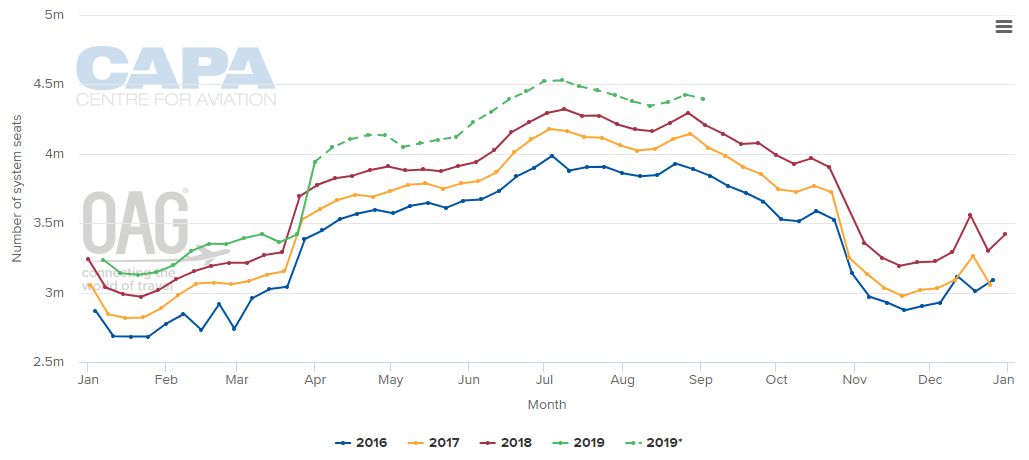Summary:
- DGAC stats show France air traffic is up close to 5% in Jan/Feb-2019 despite yellow vest riots;
- Protests are in their fourth month and show no signs of slowing down;
- The government appears to be quickly losing control of the situation, which doesn't bode well for tourism and businesses.
The DGCA noted February gains were accentuated by the differences in weather, as well as a "dramatic improvement" in the consistency of flights in 2019 compared with 2018. No mention was made of the gilet jaunes (a reference to worker's high-visibility yellow safety vests) protests. Seat capacity has dipped slightly in mid Mar-2019, though is expected to ramp up to over four million weekly seats from Apr-2019 as shown by OAG forward projections.
CHART - The impact of the protests is not currently seen on air capacity data in France with system seats up on previous years and continuing a market trend Source: CAPA - Centre for Aviation and OAG
Source: CAPA - Centre for Aviation and OAG
What began as a protest over, among other things, a since rescinded proposal on fuel tax increases, has now turned into a full-blown movement for economic justice against the ever-unpopular Emmanuel Macron presidency.
While France is renowned for its use of physical, quirky named social movements to achieve change, recent gilets jaunes protests are the worst in recent history. They have become far more violent and disruptive for day-to-day life than in the past, with few areas of France spared.
Since it started, protesters have blocked off entrances and airside areas at Nantes and Nice airports, barred toll booths on major highways and blocked off roads, fuel depots and construction sites all over France with barricades. Tens of people have died in relation to protests and hundreds seriously injured.
"Bistro" style shop fronts and hundreds of cars have been torched, small newspaper outlets have been raided au hazard. The Champs-Élysées, one of France's most iconic tourist hotspots, has been ravaged by street protests. It seems no one is exempt from the protesters' anger, not even those who one would think protesters would be wanting to leave be, making these riots particularly dangerous for those touring the city by foot.
What's worse is there is little reason to think unrest will desist any time soon. Logically, forms of protests and industrial action are more common in summer in France as people tend to be outdoors more, allowing protesters to put their point across physically amongst a larger number of people.
France's last mass social movement 'Nuit debout' (Up at night) lasted during around 2Q2016, and while it gained international attention, it was mostly centred around Paris' La République square. It was also far more peaceful in its later stages and turned into a kind of tourist attraction in Paris, with its community discussions and debates on politics and social theory in the day and its (police supervised) raves during the night.
President Marcon and Prime Minister Edouard Philippe's handling of the situation today has been questionable to say the least, and makes one think they are losing control of the situation entirely. The city is once again virtually in lock down as government has now resorted to deploying the military to defend the Champs-Élysées, banning protests and painting the protesters as an angry mob against which Paris citizens, businesses and visitors need to be protected.
Its liberal use of "non-lethal" LBDs (40mm rubber bullets) is an obvious safety risk for protesters, other law enforcement agents and unfortunate passers-by alike. Having only just got over the military presence sent in after the Paris terrorist attacks in 2015, these heavy-handed tactics will undoubtedly prompt some form of counter reaction and prolong disruption to tourism, business and commercial activities on France's most frequented avenue.
All this to say the attractiveness of France and Ile-de-France as a destination is suffering greatly. Businesses are hurting, not just from the physical damage or the loss of turnover from reduced foot traffic but the damage to Paris' image as a "luxury destination" and travellers' hesitation to plan a trip during such chaotic times. If protests aren't curbed going into the spring/summer 2019 schedule, we will start to see sharp declines in visitor numbers which can only cut airline and airport passenger numbers and cripple businesses.